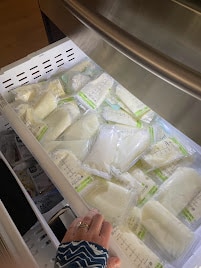A couple of months after having my first and struggling with my oversupply, I decided to try and dip into my freezer stash. During this process, I discovered I had high lipase. While I was trying to decrease my supply to something that wouldn’t choke my son, I tried having my husband give my baby thawed milk from our freezer stash. My son never refused a bottle and generally had a great appetite but he fought this bottle.
I was so confused.
After he refused that bottle, I offered the milk I just pumped. No fight. He gulped it down.
I was even more confused now. Why?
Introduce many google searches. Did my milk have “high lipase?”

What is High Lipase?
Lipase is an enzyme that is present in all milk and works to help break down the fats in milk. When there is a high amount, this will make your milk taste “off.” SOME (but not all) babies will reject this milk based on taste. My son did not like the taste of this milk. It will still break down even it it’s frozen. This was one of the reasons I decided to donate my milk!
Wait – If it Tastes Bad, Is it Bad!?
Nope! The milk is not bad and it still contains all the great nutrients for your baby. Not all babies reject this milk and generally it’s pretty uncommon for newborns to reject this milk. This, donation is a great option!
How Do I Know if *My* Milk Has High Lipase?
You may be able to tell if your milk has high lipase by smelling it, but the best way to tell is by tasting it! Fresh breastmilk is going to taste sweet. Even if you have high lipase, it will taste sweet when fresh. After refrigerating (or freezing) for some amount of time, your breastmilk will start to “turn” and kind of taste rotten. Depending on the individual, you might have more or less time than others before the taste is noticeably worse. I noticed that my milk started to taste worse after about 12 hours of refrigeration.
I REALLY Want To Use My Freezer Stash – What Can I Do?

Option 1: Alcohol Free Vanilla
I have seen recommendations that some babies will take high lipase milk if you add some alcohol free vanilla. I have not personally tried this, but would recommend talking with your pediatrician before taking this option!
Option 2: Dilute
I tried this. Turns out my baby is a bottle refused haha! So it didn’t work out for us, but some mix fresher milk with the “older” milk to help dilute the taste. Great option for using your stash but a decent amount of work.
Option 3: Scald
This does not work after you’ve already frozen your milk unfortunately… you have to do it before. Also this is the most labor intensive. Scalding milk effectively inactivates the enzyme that makes your milk taste off. There’s an exact science to this and some of the nutrients in the milk are damaged by the process. Basically, your milk will be less nutritious (but still great for your baby) by taking this approach.
This option involves temperature probes, ice baths, and generally a lot of effort. I did it once but definitely was too tired to keep up with it and instead just provided fresh milk every morning for daycare instead. By pumping consistently after the first morning feed, I was able to produce enough milk before daycare each day. I know this isn’t an option for everyone – scalding might work out better!
Option 4: Milk Baths
If baby won’t drink the milk, a milk bath can still bring plenty of benefits to your baby’s skin! Mix the milk in with a warm bath and let your baby soak! The milk is great for hydration and any skin struggles like eczema. Make sure to rinse your baby with clean water after the bath.
High Lipase Milk Conclusions
I’ve heard high lipase milk is “rare” but I feel like I’ve heard of PLENTY of moms struggling with it! The best way to know if your milk has high lipase is by taste testing your milk. remember that just because you have high lipase milk does not necessarily mean that your baby will reject it! Try to see if your baby doesn’t mind the taste. If not, you’ve got options! Any questions? Let me know what you think in the comments! Good luck mamas!
